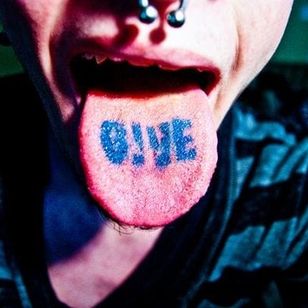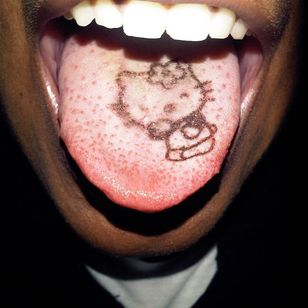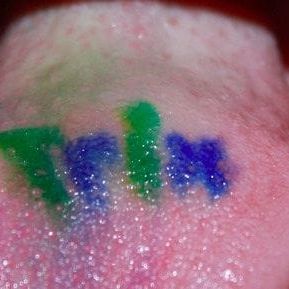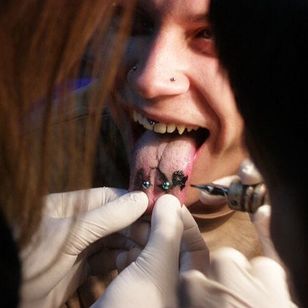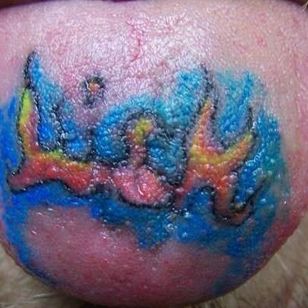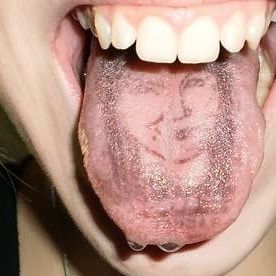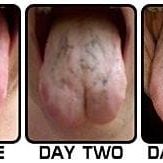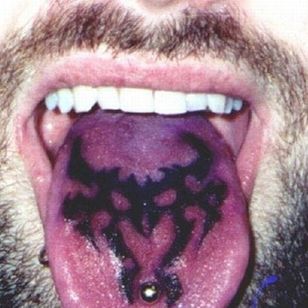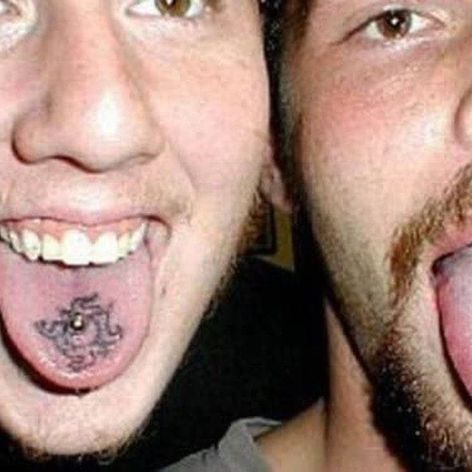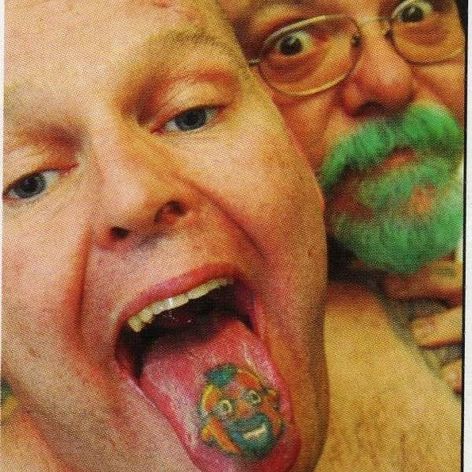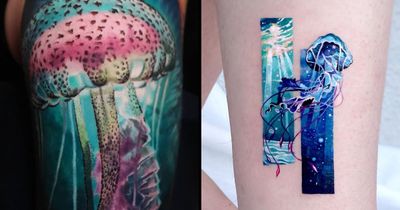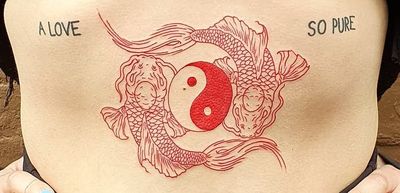Let's Talk About Tongue Tattoos

Summary
Thinking about getting a tongue tattoo? Check out our informative guide to learn all there is to know about tattooing tongues! From aftercare to the best design motifs, we’ll walk you through the entire tongue tattoo process from top to bottom
Summary
1) If you’re contemplating a tongue tattoo you’re probably wondering if it hurts. The good news is that tongue tattoos rank relatively low on the pain scale.
2) Wondering how long your tongue tattoo will last? Depending on the artist and your body’s personal chemistry, a tongue tattoo can last anywhere from a few weeks to a few years.
3) The healing process for tongue tattoos is on the shorter side, with most being fully healed in about three weeks. Pain levels during the healing process may be a bit more intense than usual.
4) While tongue tattoos can look super cool, they can also potentially impair your sense of taste by causing damage to the taste buds.
Nowadays, it’s hard to imagine a body part that hasn’t been tattooed, so for some, it will come as no surprise that tongues are included in that list.
In this article we will outline the entire process of tongue tattoos, covering expected healing time, precautions, tongue tattoo designs, aftercare, and procedural information.
So, if you’re looking to tattoo your tongue, read along to get informed on the process and make sure to check out our inspiration gallery for unique tongue tattoo ideas!
Tongue Tattoo Procedure
What should I do to prepare before my tongue tattoo?
As with any tattoo, you should always prepare by gathering reference material for your design, researching the best artists and shops for your particular placement, and ensuring that you have good hygiene before your appointment.
For a tongue tattoo, make sure to brush and floss before leaving for the shop, and use mouthwash to help further sterilize the area.
If you’re wondering “how do you make a tongue tattoo?” we are more than happy to walk you through the process! The procedure of tattooing your tongue will differ in some ways from getting a traditional tattoo.
Instead of using an electric tattoo machine, the artist will apply the design to the tongue through a series of pigment injections. While holding the tongue in a clamp, the artist will place ink directly into the capillaries within your tongue, allowing the ink to immediately disperse and saturate the surrounding tissue.
Because your tongue is covered by thick layers of epithelial tissue, traditional electric tattoo machines cannot be used to create your design. When a traditional machine is used on a tongue tattoo, the ink disappears almost immediately, thanks to the epithelial tissue's incredible ability to protect the tongue from injury and wear.
Before getting your tongue tattoo, make sure to consult your artist about this particular placement. Some tattooers will refuse to work on the tongue due to the short-lived nature of the design and the potential risk of damaging the taste buds.
If you’re looking for a tattoo on the underside of your tongue, rest assured that a regular tattoo machine can be used as the tissue beneath the tongue does not contain the many epithelial layers of the top.
Dos & Don’ts:
DO:
1) Practice good oral hygiene before your appointment
2) Consult your artist before deciding on a tongue tattoo
3) Educate yourself on the potential risks (see: Concerns)
4) Familiarize yourself with the process
5) Decide upon a tattoo motif and placement
DON’T:
1) Expect all artists to perform tongue tattoos. Make sure to consult with your artist before deciding on this placement.
2) Ignore the potential risks to your taste buds
3) Arrive at your appointment without having brushed or flossed your teeth.
Expected Pain Level for a Tongue Tattoo
Do tongue tattoos hurt?
Tongue tattoos are relatively painless in comparison to other parts of the body. Many who have undergone the process have stated that they feel a slight tingling sensation or numbness.
Although the idea of tattooing your tongue may seem frightening, it’s actually one of the least painful places to tattoo. People who have undergone the procedure commonly report that it creates a numbing sensation or a gentle tickling feeling on the tongue.
The process is fairly quick thanks to the small size of the tongue, which may also help comfort those of you nervous about the pain level.
The only real discomfort in getting a tongue tattoo is the healing process. During the first few days to the first week, your tongue may feel tingly and numb with occasional pain. The pain comes from a normal buildup of crust and subsequent flaking of the tattoo.
Thankfully, the tongue is also one of the quickest spots on the body to heal, typically taking only three weeks to fully recover.
Healing time of a Tongue Tattoo
How long does it take for a tongue tattoo to heal?
On average, it takes about three weeks for a tongue tattoo to heal.
Most tattoos take about 50 full days to heal, while tongue tattoos heal in about three weeks. Thanks to the tongues' incredibly resilient composition the healing time is accelerated, but it still comes with some pain and discomfort.
During the first few days after your tattoo towards the end of the first week, the tattoo may feel painful, tingly, and numb. These feelings will be accompanied by crust buildup and flaking of the tattoo. If this happens after your procedure, don’t freak out because it’s totally normal!
Tongue Tattoo Aftercare
How do I care for my tongue tattoo?
After getting your tongue tattoo make sure to continue practicing good oral hygiene by brushing your teeth twice a day, flossing, and using mouthwash.
Tongue tattoo healing and aftercare is a slightly different process from other tattoos, as the duration of the recovery takes place within your mouth. Healing time for tongue tattoos takes about three weeks, during which you are likely to experience a crust above the area of the tattoo.
To combat infection and protect the health of your mouth, make sure to continue practicing good oral hygiene through frequent brushing, flossing, and mouthwash. Take extra care to keep your tongue clean from bacteria during this time.
If you experience any severe pain, swelling, or fever it is advised that you visit a doctor immediately.
Dos & Don’ts:
DO:
1) Make sure to keep your mouth and tongue clean from harmful bacteria
2) Expect to have some numbness, tingling, and crust in the area of the tattoo
3) Allow about three weeks for the tongue tattoo to heal
4) Visit a doctor at the first sign of infection, swelling, or severe pain
DON’T:
1) Neglect regular brushing and flossing
2) Get nervous about the presence of crust and flaking
How long does a tongue tattoo last?
Before getting your tongue tattoo, be prepared in knowing that it may only last around two weeks to several years at best.
So, if you’re looking for a temporary tattoo, or you don’t mind going in for regular touch up’s, this placement may work for you. But if you’re searching for something permanent that will stand the test of time, this placement will disappoint you.
Depending on the technique and pigment used tongue tattoos can last a bit longer, but all will eventually degrade due to the strong enzymes and acids within your saliva that are used to help break down food particles.
The tongues incredibly protective and quickly healing layers of epithelial tissue also pose problems for your tattoo’s longevity, as the cells are in a constant state of regeneration and healing. This causes tongue tattoo’s to fade rather quickly.
Dos & Don’ts:
DO:
1) Expect your tongue tattoo to fade over time. Tongue tattoos generally last from two weeks to several years.
DON’T:
1) Get a tongue tattoo if you’re looking for a permanent design or can’t afford regular touch up’s.
Tongue Tattoo Designs
Looking for tongue tattoo ideas? You’ve come to the right place. Here, we will walk you through the most common tongue tattoo placements, as well as which type of designs work here, and which are better left for other parts of the body.
Tongue tattoos are usually in the form of simple designs such as symbols, tribal, cartoon characters, short words or geometric shapes. ... Getting intricate detail is difficult given the texture of the tongue.
When designing the concept for your tongue tattoo it’s important to envision how noticeable you’d like the tattoo to be and what subject matter you’d like to represent.
Since the tongue is a fun placement for tattoos, many people have elected to use cartoon imagery, sassy quotes, depictions of tasty foods, and stamp-like imagery of everything from hearts to peace signs.
Tattoo Galleries:
The Top 250 Best Food Tattoos of the Year
The Top 250 Best Manga Tattoos of the Year
The layout of your design is entirely up to you! So whether you’d like a small tattoo on the side of your tongue, a full-color change tattoo on your tongue, or a design on the top or tip, all are possible with an experienced artist.
When working with a small space like the tongue that tends to fade, it’s generally best to go with simple designs utilizing a black outline. Tongue tattoos done without a dark outline tend to become murky looking and provide little contrast against the fleshy backdrop of the tongue. So if you want your tongue tattoo to appear visible and bold, make sure to select a fairly simple design or word and use darker inks or a black outline.
If black ink’s not your thing, you can also experiment with using all-white ink. Many who have chosen to use white ink have created stunning sacred geometry tongue tattoos, or abstract designs covering the entire tongue area.
Dos & Don’ts:
DO:
1) Decide what tongue tattoo placement you prefer: top of the tongue, side of the tongue, beneath the tongue, or full-color saturation of the entire tongue.
2) Choose a simple and minimal design, symbol, or one-word phrase
3) Select a motif that utilizes black outlines
DON’T:
1) Select an intricate design
2) Select a design that doesn’t use black outlines
Concerns
Do tongue tattoos affect your sense of taste?
Yes, tongue tattoos can potentially damage your taste buds affecting your ability to perceive taste. If this is something you’re not willing to sacrifice for a tongue tattoo, make sure to steer clear of this placement.
Are tongue tattoos safe?
Tongue tattoos are about as safe as any other placement, aside from the heightened risk of potentially permanent damage to the taste buds.
Do tongue tattoos cause health problems?
As with any tattoo, there is a risk of infection, but with tongue tattoos, the risk is a bit higher due to the large amount of bacteria present within the mouth.
If you’ve been curious about the potential dangers of getting your tongue tattooed, you’re not alone! Many people are wary of this placement due to the large amount of bacteria present within the mouth.
One of the biggest risks you will face when getting a tattoo on the tongue is the possibility of infection. This is why it is crucial to keep the mouth as clean as possible during the healing process and limit exposure to smoke or any other kind of irritant. When contemplating tattooing your tongue, make sure to talk with your artist to gain a good understanding of the aftercare process.
Another less common but worrisome concern is damage to the taste buds. If you can’t imagine yourself losing the ability to taste in the area where your tattoo will be placed, we would suggest against going forward with the process.
It is also important to consider is the possibility that you will have an allergic reaction to the ink or metals used within the procedure. If this happens, contact your health provider right away!
Tongue and lip tattoos have also been known in certain cases to exacerbate pre-existing conditions within the mouth, so make sure you have a clean bill of dental health before moving forward.
Dos & Don’ts:
DO:
1) Inform yourself on all potential risks before moving ahead with your tongue tattoo
2) Speak to your artist about aftercare
3) Find an artist well-versed with this type of tattoo whose previous clients have reported no issues
4) Check with your dentist to make sure you have no pre-existing oral conditions which could be aggravated by the tattoo
DON’T:
1) Move forward with the procedure if you don’t want to risk damaging your taste buds
2) Select an artist at random without researching them first
3) Ignore signs of infection or swelling after the procedure
If you’ve made it this far you’re probably pretty dead-set on a new badass tongue tattoo! While there are some potential risks at play when getting a tongue tattoo, selecting an experienced artist who is comfortable with this placement will greatly aid in the success of the healing and aftercare process.
Now that you are informed on all of the best practices, motifs, and the procedure itself you’re all ready for your awesome new tongue tattoo!
